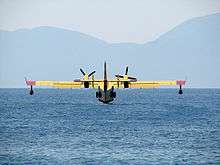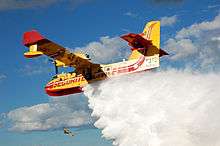Canadair CL-415
| CL-415 | |
|---|---|
.jpg) | |
| Role | Amphibious water bomber |
| Manufacturer | Canadair Bombardier Aerospace |
| First flight | December 6, 1993 |
| Introduction | 1994 |
| Status | Active service |
| Primary users | Vigili del Fuoco (Italy) Sécurité Civile (France) Hellenic Air Force (Greece) Ministry of Natural Resources and Forestry (Ontario, Canada) |
| Produced | 1993–2015 |
| Number built | 90[1] |
| Unit cost | |
| Developed from | Canadair CL-215 |
The Canadair CL-415 (Superscooper, later Bombardier 415) is an amphibious aircraft based on the Canadair CL-215 and designed specifically for aerial firefighting, built by Canadair then Bombardier.
Development
In 1987, following market trends towards more efficient, powerful and reliable turboprop powerplants, Canadair undertook the task of retrofitting 17 CL-215 airframes with the Pratt & Whitney Canada PW123AF engines, providing a 15% power increase over the original piston engines, as well as enhanced reliability and safety. The retrofitted aircraft were designated CL-215T and also featured many aerodynamic and systems improvements including powered flight controls, cockpit air conditioning, as well as upgraded electrical and avionics systems. The most notable external features of the CL-215T retrofit were the aerodynamic additions to the wings and empennage.
Based on the success of the CL-215, the company introduced the CL-415, a new-build production series beginning in 1993. The CL-415 first flew on December 6, 1993, with the first deliveries in November 1994.[3] Orders from several countries soon followed.
The CL-415 was assembled at the Bombardier Aerospace facility near North Bay/Jack Garland Airport in North Bay, Ontario, and tested on Lake Nipissing.
On June 20, 2016, Viking Air purchased the CL-415 type certificate from Bombardier along with the older CL-215 and CL-215T.[4][5][6] The acquisition was finalised on 3 October.[7]
Design
.jpg)
The CL-415 has an updated cockpit, aerodynamics enhancements and changes to the water-release system as well, creating a modern firefighting amphibious flying boat for use in detecting and suppressing forest fires. Compared to the CL-215, the CL-415 has increased operating weight and speed, yielding improved productivity and performance. The 415 can scoop up to 6,140 litres (1,620 US gal) of water from a nearby water source, mix it with a chemical foam if desired, and drop it on a fire without having to return to base to refill its tanks. The CL-415 was specifically developed to provide the capability to deliver large quantities of suppressant in quick response to fires. The aircraft is built for reliability and longevity, with use of corrosion-resistant materials. The new 415GR has higher operating weights, while the CL-415 multi-role is available for use in a paramilitary search and rescue role and utility transport.
The aircraft requires 1,340 metres (4,400 ft) of flyable area to descend from 15 metres (49 ft) altitude, scoop 6,137 litres (1,350 imp gal; 1,621 US gal) of water during a twelve-second 410-metre-long (1,350 ft) run on the water at 70 knots (130 km/h; 81 mph), then climb back to 15 m altitude. The aircraft can also pick up partial loads in smaller areas and can turn while scooping, if necessary.[8]
Operational history

Derived from its predecessor's nickname, it acquired the name, "Super Scooper" in light of its greatly enhanced performance as a water bomber and fire suppresser. In recognition of its abilities, the aircraft was awarded the Batefuegos de oro (gold fire extinguisher) by the Asociacion para la Promocion de Actividades Socioculturales. The award citation in part read "This is the most efficient tool for the aerial combat of forest fires, key to the organization of firefighting in a large number of countries. The continuous improvements to meet the needs of forest firefighting have made these aircraft the aerial means most in demand over more than 30 years."[9]
Of the 95 built, seven have been removed from service due to accidents.[10]
Variants
- CL-415
- 415 MP
- (Multi-Purpose)
- 415 GR
Operators

.jpg)

In 2018, there were 165 in-service CL-215 and CL-415s in 11 countries.[11]
- Service aérien gouvernemental, Quebec operates eight 415s.
- Ministry of Natural Resources and Forestry (Ontario) operates nine 415s.
- Department of Natural Resources (Newfoundland and Labrador) operates six 415s.
- Government Air Services, Manitoba operates four.
- Provincial Aerospace, Newfoundland and Labrador operates two 415 converted as 415MP for use for overseas clients/contracts (for Malaysian Maritime Enforcement Agency)[12]
- Croatian Air Force operates six CL-415s in 885th Firefighting Squadron.
- Sécurité Civile has received twelve CL-415s with three on order [13][1]
- Hellenic Air Force operates seven aircraft – six CL-415GRs and one CL-415MP.[1][14]
- Protezione Civile has taken delivery of nineteen CL-415s, with three more on order.[1]
- Malaysian Maritime Enforcement Agency ordered two CL-415MP, contract to Provincial Aerospace of Canada.[15]
- Moroccan Air Force received six CL-415s.
- Spanish Air Force operates three CL-415s; two on order.[16]
- Unidad Militar de Emergencias has two CL-415s on order.[16]
- Los Angeles County Fire Department leases two CL-415s from the government of Quebec for use during the wildfire season since 1994.[17][18]
- San Diego County leases two CL-415s from the Province of Quebec for use during the three-month period from September 13 to December 13.[19]
- United States Forest Service leases two to four[20] CL-415s for fighting fires on US lands. These aircraft are owned by a partnership led by Tenax Aerospace LLC and operated by Aero-Flite, Inc.[21]
Specifications (CL-415)
Data from Bombardier Aerospace Website
General characteristics
- Crew: 2 pilots
- Additional Seating: one on jump seat, eight on bench seats
- Payload: 6,400lb (2,900 kg)
- Length: 65 ft (19.82 m)
- Wingspan: 93 ft 11 in (28.6 m)
- Height: 29 ft 3 in (8.9 m)
- Wing area: 1,080 sq ft (100 sq m)
- Airfoil: NACA 4417
- Empty weight: 28,400 lb (12,880 kg)
- Maximum fuel weight: 10,250 lb (4650 kg)
- Maximum takeoff weight (from land, disposable load): 43,850 lb (19,890 kg)
- Maximum takeoff weight (from land, non-disposable load): 41,000 lb (18,600 kg)
- Maximum takeoff weight (from water): 37,850 lb (17,170 kg)
- Max Capacity (Water or Retardant): 13,536 lb (6,140 kg)
- Maximum weight after scooping: 47,000 lb (21,360 kg)
- Maximum landing weight: 37,000 lb (16,780 kg)
- Powerplant: 2 × Pratt & Whitney Canada PW123AF turboprop, takeoff power: 2,380 shp (1,775 kW) each
Performance
- Maximum speed: 223 mph (359 km/h (194 kn))
- Cruise speed: 207 mph (333 km/h (180 kn))
- Stall speed: 78 mph (126 km/h (68 kn))
- Range: 1,518 miles (2,443 km)
- Service ceiling: 14,700 ft (4,500 m)
- Rate of climb: 1,600 ft/min (8.1 m/s)
- Takeoff distance (ISA, land): 2,750 ft (840 m)
- Takeoff distance (ISA, water): 2,670 ft (815 m)
- Landing distance (ISA, land): 2,210 ft (675 m)
- Landing distance (ISA, water): 2,180 ft (665 m)
- Minimum water depth: 6 ft (1.8 m)
Avionics
- Honeywell Primus 2 Radio Navigation
- RNZ-850 with ADF, VOR/ILS/Marker Beacon and DME
- Litef/Honeywell LCR93, Attitude and Heading Reference System
- Honeywell EDZ-605 EFIS with Dual EADI and EHSI
- Radio Altimeter (Honeywell AA-300)
- Parker-Gull Three-tube Active Matrix LCD Integrated Instrument Display System
- Dual CIC/Aerosonics Air Data Computers
- Dorne & Margolin ELT-8 Emergency Beacon
See also
Related development
Aircraft of comparable role, configuration and era
References
Notes
- 1 2 3 4 "Amphibious aircraft – Status report – Bombardier". Archived from the original on 2013-11-08.
- ↑ Bombardier CL 415 cost Archived March 28, 2014, at the Wayback Machine.
- ↑ "Bombardier 415." aerospace.bombardier.com. Retrieved: April 13, 2010.
- ↑ "Viking Air to buy type certificates for Bombardier amphibians". Flight International. June 21, 2016.
- ↑ "Bombardier Announces a Definitive Agreement for the Sale of its Amphibious Aircraft Program to Viking Air Limited" (Press release). Bombardier. June 20, 2016.
- ↑ "Viking Air Limited Acquires Worldwide CL-415 Waterbomber Program from Bombardier" (Press release). Viking Air. June 20, 2016. Archived from the original on June 23, 2016.
- ↑ "Viking completes acquisition of Bombardier's amphibious aircraft programme". Flight Global. 3 October 2016.
- ↑ "Firefighting Techniques and Technologies: Water scooping." bombardier.com. Retrieved: April 13, 2010.
- ↑ "Bombardier 415 SuperScooper Amphibious Aircraft." Newatlas.com. Retrieved: June 11, 2017.
- ↑ "Canadair CL-415." Archived December 5, 2007, at the Wayback Machine. baaa-acro.com. Retrieved: July 29, 2011.
- ↑ Amy Laboda (October 12, 2018). "Viking Air Preps for Fire Season, Updates Water Scooper Line".
- ↑ Provincial Aerospace | Provincial Aerospace Awarded $4M Contract to Modify Maritime Surveillance Aircraft Archived July 12, 2012, at the Wayback Machine.
- ↑ Keijsper 2008, p. 40.
- ↑ Keijsper 2008, p. 41.
- ↑ Vogelaar, Rob."Bombardier Sells Four Bombardier 415 Amphibious Firefighting Aircraft to an Undisclosed Customer." aviationnews.eu, March 28, 2011. Retrieved: July 29, 2011.
- 1 2 Keijsper 2008, p. 43.
- ↑ Zev (September 14, 2011). "Fighting fire with some super friends". Los Angeles County. Archived from the original on January 18, 2014. Retrieved January 16, 2014.
- ↑ Bartholomew, Dana (August 26, 2013). "Canadian Super Scoopers arrive early in L.A. County to take on fire season". Los Angeles Daily News. Retrieved January 16, 2014.
- ↑ "County leases fire-fighting planes from Quebec." SignOnSanDiego. Retrieved: July 29, 2011.
- ↑ http://fireaviation.com/tag/aero-flite/
- ↑ "Bombardier Announces First U.S. Bombardier 415 Aircraft Sale and Delivery to a Partnership Led by Tenax Aerospace, LLC".
Bibliography
- Pickler, Ron and Larry Milberry. Canadair: The First 50 Years. Toronto: CANAV Books, 1995. ISBN 0-921022-07-7.
- Keijsper, Gerard. "Water-Bombers Required!" Air Forces Monthly, London: Key Publishing, July 2008 Issue.
- Marsaly, Frederic and Samuel Pretat. "Bombardiers d'eau/ Canadair Scoopers." Editions Minimonde76, May 2012, ISBN 978-2-95418-180-6.
External links
| Wikimedia Commons has media related to Canadair CL-415. |